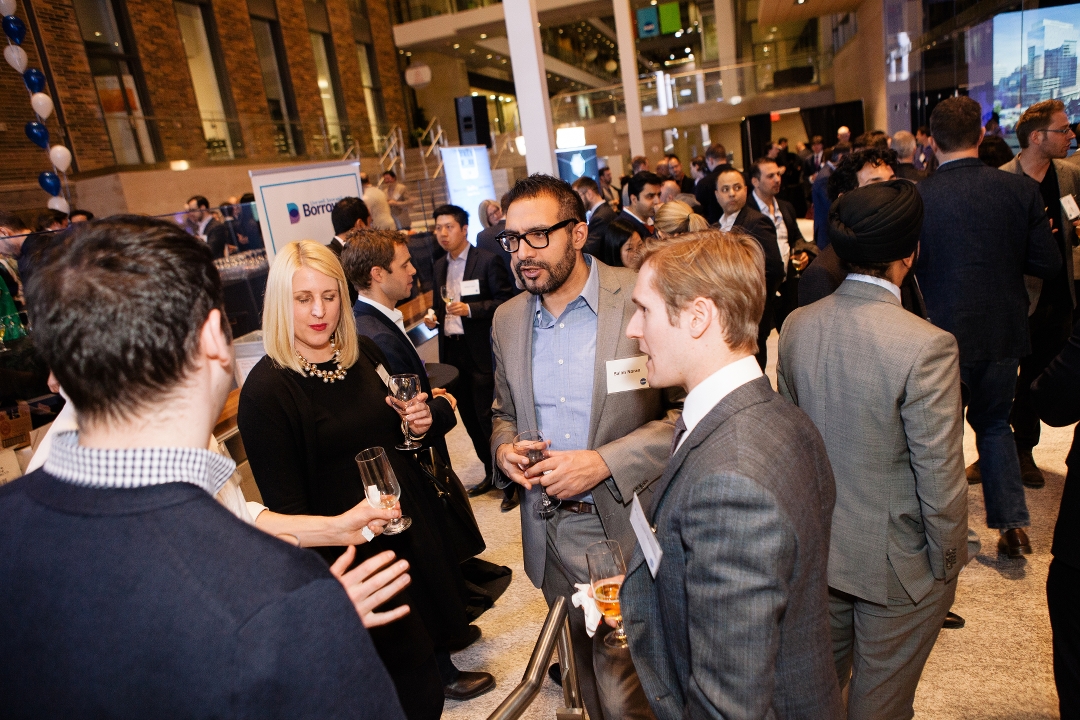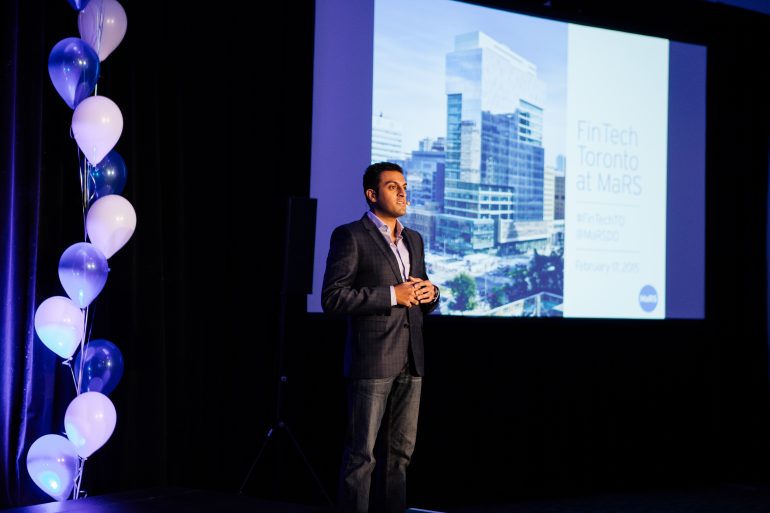Last week, MaRS launched its new financial technologies cluster. The announcement, filled with partners across the financial, venture capital, and entrepreneurial space, was a major bet by the innovation centre on the potential of FinTech in Canada. We sat down with Adam Nanjee, the man running the cluster (and disclosure, a former co-worker of mine at BlackBerry), to understand how he plans to make Canada a global FinTech leader.
Of all the places MaRS could invest its time and energy, why would it choose FinTech?
Like I mentioned yesterday, there are so many entrepreneurs in the FinTech space. And it’s not just in one area – we talked about cryptocurrency, and I mentioned alternative lending, and P2P payments. We’re seeing a tremendous amount of growth in these sectors. You’re talking about probably over 100 FinTech entrepreneurs across all these sectors.
And as you saw yesterday, there’s a lot of appetite from the financial institutions to do something here – they just didn’t have a place to go to find all these folks.
I think the third part is the international perspective. There are dedicated financial technology things happening in London and in New York, and I think Toronto has an opportunity to play in that space.
Is this a Toronto opportunity or a Canadian opportunity that Toronto’s institutional relevance can leverage?
I’d say this cluster is for Canada. We had entrepreneurs yesterday from Vancouver and Montreal. It happens to be located in Toronto, because of where our financial technology infrastructure is, but it’s absolutely for Canada.
So what role does MaRS play? Is MaRS facilitating something that can happen on its own, or is MaRS needed to connect these people? Because there were a lot of different people in the room last night with a vested interest in FinTech, and none of them knew each other because they’re all coming from different worlds.
What we’re trying to do is two things. One, create an ecosystem where all these folks can come under one roof, that’s the first step. The second step deals with how they go about being connected. How does an entrepreneur meet the head of digital payments at a bank? At MaRS, we are going to be that bridge to connect these folks.
That’s actually been the biggest desire from the community, across all the entrepreneurs, all the financial institutions, and even the venture capital folks. They all said, ‘there are so many things happening across the FinTech space, we just need a place to meet and cross-pollinate and tap into these innovations.
I’ll use the entrepreneurs in the cryptocurrency side as an example. They actually came to us and said they wanted to find out some of the other entrepreneurs in their own space – even if it’s kind of competitive, to bounce ideas off each other.
Is it surprising that there’s an interest in connection at all levels? Because entrepreneurs always want to get in front of money, but the banks and payment institutions seem actively willing to connect with innovation.
A lot of the FinTech entrepreneurs I’ve spoken to over the past few months have said that more so than a desire for venture capital funding is a connection to showcase their technology and actually acquire customers. A lot of these FinTech entrepreneurs are looking at the MasterCards of the world, PayPal, some of the banks, to potentially beta their technology – they’re actually building some of their technologies to cater to these institutions.
It’s very difficult to say ‘I want to speak with the head of digital at these institutions.’ Where would they go? The banks have tens of thousands of employees, so how do they go about getting connected? At yesterday’s event, we had a lot of entrepreneurs saying things like, ‘ can you introduce us to the head of PayPal Canada mobile, because we’re building a mobile payments technology?’ Right there at the event we were able to bridge that gap, because this cluster is very focused on helping entrepreneurs grow, whether it’s venture capital or a financial institution.
So then what’s your specific role, and why are you the right person to lead this?
The primary goal is to really drive entrepreneurship and innovation for Toronto and Canada, and contribute back to this economy. If MaRS can help these entrepreneurs grow – either getting them a customer, helping them get invested – if we can help get entrepreneurs more connected to the venture capital firms, that’s a success metric for us.
If we can get some of the banks and the financial institutions getting more innovative, and when I say getting more innovative I mean sponsoring events, investing in companies, we can start getting that momentum going. I will tell you that we’ve had a lot of traction with banks outside of Canada, in the UK and in Silicon Valley, that want to come up and see what we’re doing here and play in the space. It would be interesting if our own Canadian banks who are five blocks away don’t start getting into this movement.
I used to run digital payments at MasterCard for the past three years, including mergers and acquisitions for corporate development. So I’ve actually met a lot of the entrepreneurs already scouring companies for MasterCard. MasterCard recently as you know invested in Nymi. And as soon as that investment happened, a lot of MasterCard’s competitors started having a desire to get in this space because they saw MasterCard doing a Canadian investment in FinTech. So I think I’ve got a good grasp on the startup ecosystem, the venture capital ecosystem, and the financial space.
So you’re basically looking to accelerate some of the things you were doing at your previous job, but for the whole space.
I would say this: MaRS is Canada’s largest entrepreneurial and innovations hub. We’re not taking this as an accelerator or incubator approach. We’re taking this as, MaRS wants to be the epicentre in Canada for FinTech and own that ecosystem. I think we have the scale to be able to do it, I think we have the partnerships to be able to do it, and I think we have the ability to bring entrepreneurs here and connect them. So when someone from Barclays bank in the UK comes in and wants to get access to the FinTech movement in Canada, I want them to know its in MaRS.

How does a cluster differentiate from an incubator or an accelerator? What does that functionally look like?
For all the startups that are going to come into the FinTech cluster, MaRS won’t take an equity stake in any of them. The reason for that is we truly want to help the entrepreneurs grow. MaRS is essentially measured on helping entrepreneurs grow.
Here’s what that means: we had a company here from Vancouver called Koho, and they said if we can continue building this space, they would consider coming to Toronto more so they could have access. And we had interest from four or five FinTech startups in Vancouver, and a few from Montreal, so there’s already this momentum –
– Okay so let’s follow up on that because I would assume that a lot of these FinTech companies are also mobile companies as these devices become the hub for all sorts of transactions. Why is mobile such a primary focus right now?
Doug, mobile payments have been around for quite some time, especially in Canada around the whole NFC movement, etc. I think with the emergence of Apple Pay coming into the market, and the whole wearables movement, mobile payments or device-enabled payments is having a resurgence. A lot of companies are building specs for Apple Pay when it comes to Canada.
But I think to your point, we have all the major banks here, we have all the major Canadian telcos that have offices in downtown Toronto, we have all the major credit card networks that have offices in downtown Toronto, so I think you’re seeing that mobile and payments go hand in hand. You’re seeing that with Apple Pay and that’s also why we partnered with UGO too, right? There are a lot of devices out there that aren’t iOS devices.
One last point, I’ll tell you that we’ve had a lot of interest yesterday from some of the telcos, asking ‘how do we play in this space as well?’
Let’s talk about that. My compatriot Daniel Bader would say that, structurally, Canada is set up for a payments revolution technology-wise. When it comes to the business infrastructure, there is either legislation or corporate interest against the kind of connectivity that is needed for payment support. Because no mobile user wants to have ten wallets. So with the interest that you’re seeing from the banks and the telcos, are they willing to concede the need for participation rather than own an end-to-end solution?
I think there’s still that issue that you’ve mentioned around a truly mobile wallet. I think UGO has done a great job starting that movement, but you’re right, to have a truly open wallet you need to be able to put any card on any device in one particular wallet. There is still a struggle with the financial institutions amongst themselves, and the telcos amongst themselves.
I actually saw this, Doug, during our BlackBerry days, when we were all trying to figure out, ‘who’s going to take the stake?’ Is it going to be the credit card networks? Is it going to be the banks? Is it going to be the carriers? Who is it going to be? I think Apple, with Apple Pay, is on the right track. They’re saying, ‘we’re going to do this. Credit cards and banks, do you want to be onboard?’ And they’re helping to fund some of the merchant retail PoS terminals, and that’s truly the only way to get mass adoption.
Because you’re right, there’s still an infrastructure issue in Canada. We have a few mobile payment solutions in Canada already, but are our enterprises and retail outlets going to pay to upgrade their point of sale terminals to accept even NFC payments? Because a lot of them don’t have that today. So I think people are still trying to solve that ubiquity.

That Interac level of ubiquity.
Yeah. I can tell you that we’ve seen a lot of interest from some of the other networks, Interac and a few others. Visa Debit has launched in Canada with quite a few products, and I think MasterCard debit is coming out as well. I think we’re going to see an emergence of the debit products come through.
In Canada, we’re unique. We have all these debit products, all these credit products, these carriers that play in different sandboxes – Rogers is a bank now. I’ll use an arbitrary example: will you ever see your Royal Bank Visa card in your Rogers Bank wallet? I don’t know, but to get to a truly open wallet, someone has to say ‘we are going to accept everything.’
So looking at this space in 2015, what’s the next shoe to drop?
I would say that of all the sub-categories within financial technology, I think we’re going to see a lot of announcements and new technology around cryptocurrency. Particularly from the startup side.
I have seen so many do many different platforms and technologies based off of cryptocurrencies. For example, we’re to a few companies that are building security exchanges using blockchain. We are seeing companies building online casinos using Bitcoin. MaRS is making a big bet that cryptocurrency will be part of the cluster in a big way. Outside of the currency fluctuation of Bitcoin, the technology behind it is very, very compelling.
One of the reasons why we partnered with Decentral Toronto, is that we want to educate the financial institutions about cryptocurrency and its true power.
Images courtesy Calvin Thomas.


